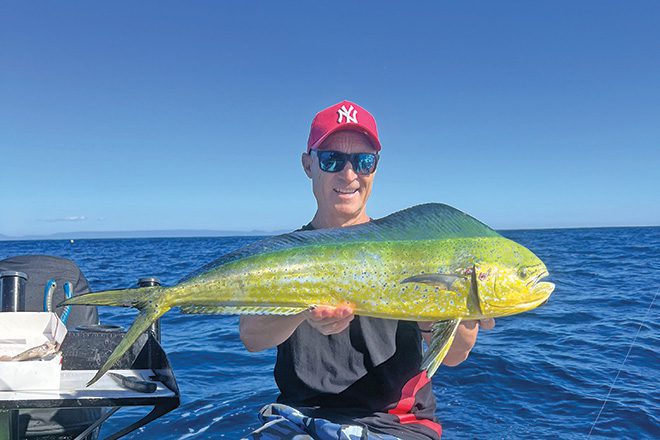This time of year is simply heaven sent. Glassed out cool mornings extending into beautiful sunny days are what mid-winter fishing is all about.
And, more often than not, the trip goes well into the afternoon for that hot evening bite.
Though I haven’t had as much time on the water as previously because of business commitments, the days I have had out were spectacular.
All kinds of fishing turn on in July, with snapper in full swing anywhere from the close reefs off the Gold Coast, right out to the 50-fathom grounds off Jumpinpin Bar, and everywhere in between.
Big mulloway are lurking about their usual haunts in the Seaway or close reefs and love nothing more than a big live bait, soft plastic or vibe.
Pearl perch are going to be chewing hard around the wire weed at the 36-fathom line east of Surfers Paradise, and there could be the occasional mahi mahi still hanging around for those who set a live yellowtail scad out behind the boat.

Cobia – or black kingfish as they’re also known – are keen on swallowing down a bait or two at this time of year, so get rigged up for a couple of options when preparing for your next trip.
Having a selection of rods for different purposes is something to think about because there are so many species out there to target.
An option to consider is a 7’ overhead snapper stick rated to 8-10kg with a good overhead reel loaded with 15-20lb monofilament line for snapper.
I’d also be taking a similar rod with 30lb braid to run a paternoster rig on for bottom fishing for pearl perch.
Two or three-hook dropper rigs work well made of 40-60lb mono.
The third rig would be a jigging style setup for chasing a big kingfish if you see them on the sounder when float-lining for snapper.

The beauty of having all your gear pre-rigged is that you can make the most of any opportunity as it arises.
We often see kingies below the boat when fishing for snapper and it’s a split-second decision to place the snapper rod in the holder, grab the jig gear and plunge a knife down onto their noses when you see them pop up.
If I’m taking a fourth setup, it’s probably going to be a slow-pitch setup.
This kind of fishing is sometimes technique specific but doesn’t always have to be, and winter is a great time to try it because the current generally slows to a bare minimum over the cooler months.
The advantage of having a slow-pitch rod is that you can tie on anything – from a flutter-style jig to an octopus or even a soft plastic – and it will do the job just fine.
Taking jigs in different sizes from 40g up to about 100g is your best bet, so you can vary the weight to keep the line vertical under the boat, allowing you to have good contact and feel for not only the action of the jig but also the strike from the fish.

Colours vary quite a bit but it’s up to you as to what you choose.
Though I do prefer something with a bit of orange in it, alternatively a natural colour usually works well too.
The thing is, if you come across a school of hungry fish, they will hit almost anything you put in front of their faces.
As I always say, try to work out the best bite time for the given day and make sure you’re on the spot at that time.
Use your sounder to spot the fish first – it’s possibly one of the most important things you can learn.
Tip is, get a good transducer – don’t use the one that came in the box unless you’re fishing in water only 30m deep or less.
In fact, it’s better to spend the money to get a good 1kW transducer and a quality sounder with a good processor and matching 1kW output than it is to by four or five extra rod and reel combos.

And don’t get misled that having a massive screen means the sounder is better.
I have only a 9” screen but because the unit can run the full 1kW, I get to see fish and bottom hardness that is a blur on some other units.
Of course, the more power, the more you’re going to see but most setups will generally start at about $1500 for the transducer and $2500 for the head unit and work their way up from there.
Though once installed and you start catching more fish, they will pay for themselves – or at least, that’s what I tell my better half!
Anyway, have an awesome time on the water this month.
Remember to check out the Queensland Fisheries website to familiarise yourself with the snapper and pearl perch closures, and pack a warm jumper.
 Bush ‘n Beach Fishing Magazine Location reports & tips for fishing, boating, camping, kayaking, 4WDing in Queensland and Northern NSW
Bush ‘n Beach Fishing Magazine Location reports & tips for fishing, boating, camping, kayaking, 4WDing in Queensland and Northern NSW









